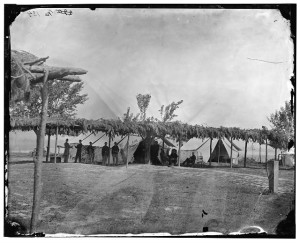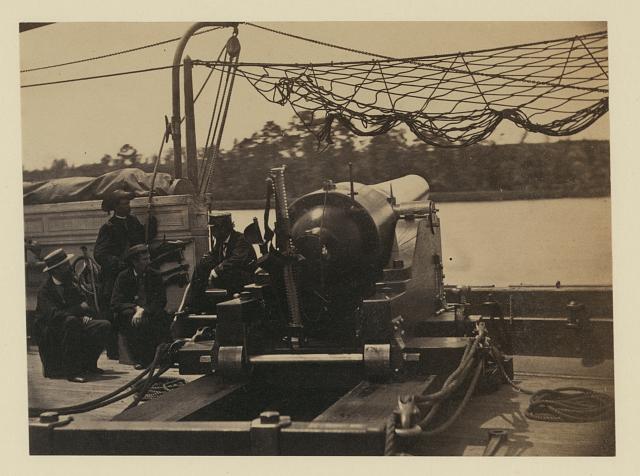From the Richmond Daily Dispatch July 9, 1864:
Additional from the North.
From Northern papers; of the 4th inst, we gather a variety of interesting intelligence, which we condense in the summary below: …
With the consent of Gen Grant, the Christian Commission has sent to City Point, from Baltimore, steam engine No. 4, for the purpose of forcing water from the James river to the hospital, a distance of one mile from the river. Some of the hospitals are located at such a distance from the river as to cause great difficulty in obtaining water for the patients. Several thousand feet of hose were also sent with the engine. Wesley Shaw, Assistant Engineer of the Baltimore Fire Department, Mike Donn, the engineer, and Jas Hall, the assistant engineer of No. 4, accompanied the engine.
You can read more about City Point at the Encyclopedia Virginia, including some information about its hospitals:
During the occupation, City Point was also home to the Depot Field Hospital, actually a group of hospitals serving the Second, Fifth, Sixth, and Ninth corps of the Army of the Potomac; a separate, affiliated hospital served the cavalry. Black Union troops were cared for in a segregated hospital until all United States Colored Troops in the Army of the Potomac were transferred to the Army of the James in December 1864. The sprawling hospital complex consisted of 1,200 tents in the summer of 1864, but these were soon replaced by 90 wooden buildings and 452 tents sufficient to house just more than 5,400 men. The hospital also had a water tower, kitchens, a dining hall, and an ice house. In 1865 alone, 29,000 patients were admitted, with 53 percent being transferred to hospitals farther north. Another 41 percent were returned to the front. Only 2 percent, or 572 patients, died while under care there.
At the US Army Quartermaster Foundation Captain Robert O. Zinnen, Jr. wrote about the hospitals in “City Point: The Tool That Gave General Grant Victory” and mentioned the water pumped from the James:
The medical care received by the wounded Union soldiers represented the finest in medical attention that that time period had to offer the sick or injured. Of the seven hospitals eventually located at City Point, the Depot Field Hospital was the largest and was able to provide care for 10,000 patients. Surgeon Edward B. Dalton commanded this tremendous operation of 1,200 tents, which blanketed 200 acres. As the weather cooled, 90 log buildings, 20 feet by 50 feet were built to house the wounded, but operations still required that 324 tents remain in use throughout the winter. Nurses ensured that each patient, who had his own bed and washbasin, was clean and comfortable by regularly providing clean linens and clothes.
These hospitals represented self-contained cities. They operated their own supply system very similar to the modern day network. The hospitals requisitioned, received and stored their own supplies. This system functioned so smoothly that the soldiers never lacked the necessary medicine or equipment. The hospitals ran their own laundries, dining facilities and dispensaries. These medical facilities even had running water, pumped from the James River, to assist in keeping the hospital as sanitary as possible under field conditions. These hospitals received vast amounts of assistance from civilian agencies such as the Christian Commission and the U.S. Sanitary Commission. These agencies provided fresh and canned fruit to help lift the health and morale of the soldiers. Each Corps had their own Sanitary Relief Station consisting of two wagons. These relief stations issued 100 tons of canned tomatoes, 1,200 barrels of cucumbers and 17,000 cans of Sauerkraut. The soldiers at City Point even had a lemonade stand to quench their thirst. Usually, two or three ships, loaded with goods supplied by these civilian commissions, sat at City Point waiting to unload their “treats.”
_____________________________________________
Meanwhile, at a different point along the James, the following photo of the U.S.S. Mendota was taken 150 years ago today while the ship was serving in the James River (Va.) Division, North Atlantic Blockading Squadron:


